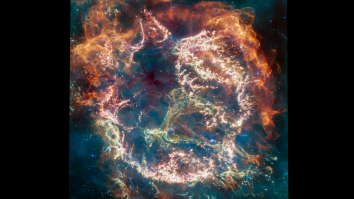Image of a supernova remnant reveals wonders, beauty, secrets of star structure and building blocks of life.Cassiopeia A (Cas A) is a supernova remnant located about 11,000 light-years from Earth in the constellation Cassiopeia. It spans approximately 10 light-years. This new image uses data from Webb’s Mid-Infrared Instrument (MIRI) to reveal Cas A in a new light. Credits: NASA, ESA, CSA, D. D. Milisavljevic (Purdue), T. Temim (Princeton), I. De Looze (Ghent University). Image Processing: J. DePasquale (STScI).Download the full-resolution version from the Space Telescope Science Institute.
JWST First Stunning Image of Cassiopeia A, Fragments of a Hellish Explosion
7 April 2023
BY COLLEGE OF NATURAL SCIENCES STAFF WRITER
To gaze at the stars is human. To be able to see them in three-dimensional detail is very nearly divine.
Divine vision is what the James Webb Space Telescope has granted earthbound scientists in a new near-infrared, detailed image of Cassiopeia A (Cas A), a stellar remnant – the clouds of gas, dust and other material left behind when a star dies.
“We have not previously seen Cas A in the infrared and in such detail, with both visual images and spectra, as JWST provides,” said Craig Wheeler, professor emeritus of astronomy at The University of Texas at Austin and a member of the team analyzing the new observations.
Cassiopeia A is the youngest known remnant from an exploding, massive star in our galaxy, which makes it a unique opportunity to learn more about how such supernovae occur. The light from its explosion first arrived at Earth 340 years ago.
“Cas A represents our best opportunity to look at the debris field of an exploded star and run a kind of stellar autopsy to understand what type of star was there beforehand and how that star exploded,” said Danny Milisavljevic, assistant professor of physics and astronomy at Purdue University, who studies supernova remnants and leads a year one research team on JWST examining Cas A.
Supernovae like the one that formed Cas A are crucial for life. Stars create a variety of elements, and subsequent supernovae create additional elements – everything from the calcium in our bones to the iron in our blood – and spread them across interstellar space, seeding new generations of stars and planets.
“By understanding the process of exploding stars, we are reading our own origin story,” Milisavljevic said.
Wheeler noted that despite decades of sophisticated research, many questions still remain about Cas A that JWST might start to help answer.
“I want to know in what sense Cas A is typical of the explosions of massive stars and in what sense is it unique,” Wheeler said. “Cas A may have arisen in a binary star system. I would love to know whether JWST provides new clues to that origin.”
Looking with new eyes
Located about 11,000 light-years away, the remnant is in the section of the sky considered to be of the constellation Cassiopeia. An arrangement of five bright stars in a “W,” Cas A is invisible to human eyes from Earth but occupies the space that appears to be off to the right of the last stroke of the W.
For decades, scientists have studied Cas A. Examining the structure using different wavelengths of light gives astronomers new insights into star anatomy, the same way infrared cameras give humans different information than cameras that see only in the visible light spectrum.
The new image collected by JWST’s golden honeycomb of 18 mirrors shows incredible detail. In it, mid-infrared light has been translated into visible light, allowing scientists to analyze details and structures. Great curtains of material, shaded red and orange, represent where the star’s material is crashing into circumstellar gas and dust. Among those rosy swaths, bursts of pink show where the star’s composite elements, including oxygen, argon and neon, are shining.
For the researchers, one of the most puzzling elements of the image is the large green loop on the image’s right side.
“We’ve nicknamed it the Green Monster, in honor of Fenway Park in Boston,” Milisavljevic said. “If you look closely, you’ll notice that it’s pockmarked with what look like little bubbles. The shape and complexity are unexpected and challenging to understand.”
Higher resolution images, in more wavelengths especially the infrared, give astronomers a clearer look at the intricacies of the structure. Like picking up binoculars to help resolve the colors and patterns on a bird’s wing, the more detail scientists have, the more information they can infer and analyze.
“Compared to previous infrared images, we see incredible detail that we haven't been able to access before,” said Tea Temim, a program co-investigator from Princeton University.
Dust to dust
Counterintuitively, some of the most exciting matter in the picture may seem the most prosaic: dust. While the substance is irritating to housekeepers, it is intriguing to astronomers.
Massive quantities of dust suffuse even very young galaxies in the early universe. It’s difficult to explain the origins of this dust without crediting supernovae, which spew large quantities of heavy elements – the building blocks of dust – across space.
But supernovae can also destroy dust, and it’s unclear how much survives the trip to interstellar space. By studying Cas A with JWST, astronomers hope to gain a better understanding of its dust content, which can help inform our understanding of where the building blocks of planets – and ourselves – are created.
“In Cas A, we can spatially resolve regions that have different gas compositions and look at what types of dust were formed in those regions,” Temim said.
Carl Sagan famously assured humanity that we are made of “star stuff.” Milisavljevic’s team and JWST’s observations are helping scientist understand that process.
“Webb is an incredible achievement,” Milisavljevic said. “I feel fortunate to be among the first scientists to test its unrivaled power to explore the universe. I am going to spend the rest of my career trying to understand what’s in this data set.”






